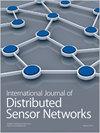A distributed scheme for energy-efficient event-based target recognition using Internet of Multimedia Things
IF 2.5
4区 计算机科学
Q3 COMPUTER SCIENCE, INFORMATION SYSTEMS
International Journal of Distributed Sensor Networks
Pub Date : 2022-05-01
DOI:10.1177/15501329221100326
引用次数: 2
Abstract
The availability of low-cost embedded devices for multimedia sensing has encouraged their integration with low-power wireless sensors to create systems that enable advanced services and applications referred to as the Internet of Multimedia Things. Image-based sensing applications are challenged by energy efficiency and resource availability. Mainly, image sensing and transmission in Internet of Multimedia Things severely deplete the sensor energy and overflow the network bandwidth with redundant data. Some solutions presented in the literature, such as image compression, do not efficiently solve this problem because of the algorithms’ computational complexities. Thus, detecting the event of interest locally before the communication using shape-based descriptors would avoid useless data transmission and would extend the network lifetime. In this article, we propose a new approach of distributed event-based sensing scheme over a set of nodes forming a processing cluster to balance the processing load. This approach is intended to reduce per-node energy consumption in one sensing cycle. The conducted experiments show that our novel method based on the general Fourier descriptor decreases the energy consumption in the camera node to only 2.4 mJ, which corresponds to 75.32% of energy-saving compared to the centralized approach, promising to prolong the network lifetime significantly. In addition, the scheme achieved more than 95% accuracy in target recognition.基于多媒体物联网的分布式节能事件目标识别方案
用于多媒体传感的低成本嵌入式设备的可用性鼓励了它们与低功耗无线传感器的集成,以创建能够实现被称为多媒体物联网的高级服务和应用的系统。基于图像的传感应用受到能源效率和资源可用性的挑战。多媒体物联网中的图像传感和传输严重消耗了传感器的能量,冗余数据溢出了网络带宽。文献中提出的一些解决方案,如图像压缩,由于算法的计算复杂性,并不能有效地解决这个问题。因此,使用基于形状的描述符在通信之前本地检测感兴趣的事件将避免无用的数据传输,并将延长网络寿命。在本文中,我们提出了一种新的方法,即在一组节点上形成一个处理集群,以平衡处理负载的分布式基于事件的感知方案。这种方法旨在减少一个感测周期中每个节点的能量消耗。实验表明,我们基于通用傅立叶描述符的新方法将相机节点的能耗降低到仅2.4 mJ,与集中式方法相比,节能率为75.32%,有望显著延长网络寿命。此外,该方案在目标识别方面达到了95%以上的准确率。
本文章由计算机程序翻译,如有差异,请以英文原文为准。
求助全文
约1分钟内获得全文
求助全文
来源期刊
CiteScore
6.50
自引率
4.30%
发文量
94
审稿时长
3.6 months
期刊介绍:
International Journal of Distributed Sensor Networks (IJDSN) is a JCR ranked, peer-reviewed, open access journal that focuses on applied research and applications of sensor networks. The goal of this journal is to provide a forum for the publication of important research contributions in developing high performance computing solutions to problems arising from the complexities of these sensor network systems. Articles highlight advances in uses of sensor network systems for solving computational tasks in manufacturing, engineering and environmental systems.

 求助内容:
求助内容: 应助结果提醒方式:
应助结果提醒方式:


